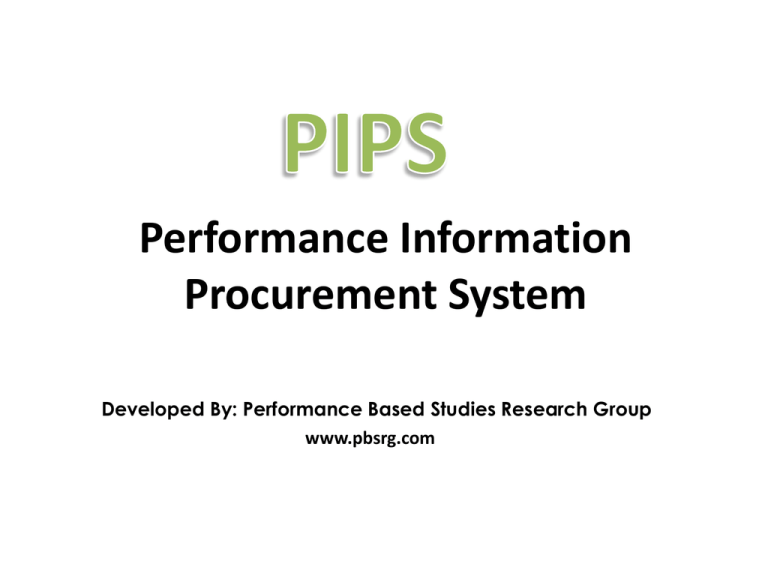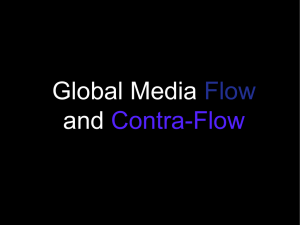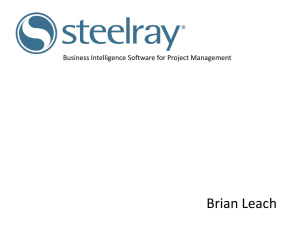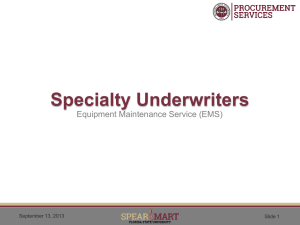PIPS-Training
advertisement

Performance Information Procurement System Developed By: Performance Based Studies Research Group www.pbsrg.com High Vendor Performance III. Negotiated-Bid II. Value/Performance Based Owner selects vendor Negotiates with vendor Vendor performs Best Value (Performance and price measurements) Quality control Contractor minimizes risk IV. Unstable Market I. Price Based Specifications, standards and qualification based Management & Inspection Client minimizes risk Low Perceived Competition High What is Performance or Value-Based Contracting According to: .com • In the performance-based approach, an agency says what problem needs to be solved and allows contractors to make bids detailing their proposed solutions. Price vs. Performance Based Price-Based: • Agency tells the vendor what to do and how to do it • Agency gets the minimum acceptable quality for the lowest possible price Performance-Based: • Agency tells the vendor what its objectives and budget are • Vendor tells agency the best way to achieve its objectives within its budget Oklahoma’s PIPS Experience 2008-2012 • Procurement savings of $30 million • Percent where selected vendor was lowest cost: 92% • Budget deviation after award: -.0003% • Schedule deviation after award: 0.5% • Agency satisfaction with PIPS: 9.5/10 • Vendor satisfaction with PIPS: 9.8/10 What does PIPS offer? • Saves time and effort for OHCA and bidders • Bidders with superior expertise can easily differentiate themselves • OHCA doesn’t have to know exactly what it wants and can rely on bidder expertise • Bidder develops its own plan, measures deviations, and controls the project • Simple and transparent, relying on verifiable metrics and dominant information • Simple and concise • Understandable to non-experts • Demonstrates understanding of the project • Always verifiable and generally quantitative • Careful – quantitative is not ALWAYS dominant Non-Dominant Dominant • Roof material has been installed on 65 buildings and is performing: – Average Roof Age: 25 years – Percent Not Leaking: 99% – Customer Satisfaction: 9.8/10 Non-Dominant • Roof material is high performing: – – – – Tensile strength is 800 PSI Elongation is 300% Tear strength is 400 lbs Xenon testing: 10,000 hrs Just because you use numbers does NOT mean it’s dominant if it’s not clear and understandable to nonexperts. Performance Information Procurement System Vendor is an Expert Vendor is an Expert CLARIFICATION Vendor expertise must be proven Dominant Simple Differential Clarification Both parties may walk Risk Management Quality Control Quality Assurance PIPS PROCESS Vendor is an expert Quality of Vendors High Low Filter 2 Project Capability Filter 3 Interview Filter 4 Prioritize (Identify Best Value) Filter 5 Cost Verification Criteria Interview TR NTR VA Cost PPI Dominance Check Blind Rating Technical Risk of Competitors Non-technical risk (no control) Value Added Cost Proposal Milestones (percentage quicker) Selection Phase Ratings are dominant Best value is within cost range Filter 6 Pre-Award Period PA Docs WRR RMP Tech. Coord. Award Filter 1 Past Performance Information Time Vendor’s expertise must be proven Selection Criteria • • • • • • Past Performance Information (PPI) Project Capability (PC) – 2 pages Risk Assessment Plan (RA) – 2 pages Value Added (VA) – 2 pages Price Interview Rating System • Two parts for each item: – The Bidder’s claim or statement about its capabilities, approach, risk mitigation plan, etc. – Dominant information/verifiable metrics to substantiate each claim • High performance indicator with dominant information 6-10 • No dominant information or unclear or blank or providing no information 5 • Low performance indicator with dominant information 1-4 Project Capability Submittal Claim: Best company in the Midwest with a unique focus on clean room projects Dominant information to substantiate: 1. 20 clean room projects in the last five years 2. scope $50M 3. customer satisfaction 9.5 4. cost deviation .1% 5. time deviation 1% Risk Assessment Submittal Risk: Excessive transactions, information flow or complaints from client’s personnel Claim: Project Manager uses the clarification period to identify client’s personnel who will cause the most transactions and complaints to discuss their expectations, educate them about the project plan and minimize unnecessary transactions. Dominant information to substantiate claim: 1. Project manager has 10.0 rating on last five projects. 2. Zero complaints at the end of the last five projects. 3. No deviation from schedule on the last five projects. More Risk Plan Examples • Identified risk: Rapidly rising cost of concrete • Claim without dominant information – The client can be assured all risks associated with material escalations will be eliminated because we offer the benefit of an experienced project team that includes the most detailed, prequalified and extensive list of subcontractors and suppliers from around the world. • Claim with dominant information – Since this project requires a substantial amount of concrete, we have secured and signed a contract with a local concrete manufacturer to prevent any increase in cost during the duration of this project. Value Added Submittal Claim: Vendor will track all building major components for the first year including energy consumption, and give client recommendations to extend life of the building Verifiable performance metrics: 1. This service provided on our last five projects. 2. Performance information: – – – 9.5/10 customer satisfaction with additional service 0 deviation from cost or schedule Customers identified savings of $4 million based on this service; references and documentation available upon request More Value Added Submittal Claim: The client’s RFP specifies 10 foot ceilings in the restrooms. While 10 foot ceilings are desirable in many areas, our experience is that lower ceilings in restrooms do not diminish the attractiveness or functionality of buildings. Reducing ceiling height to 8 feet results in a 5% decrease in cost and a 3% reduction in time to complete. Verifiable performance metrics: 1. 10 similar buildings completed with 8 foot ceilings in restrooms 2. Client satisfaction with buildings 9.9/10 3. Buildings rented at 102% of projected rental amount • OHCA will interview key personnel, including the Project Manager and others as specified. • All individuals will be interviewed separately and preferably in person; OHCA may approve telephone interviews in certain circumstances. • No substitutes will be allowed after proposals are submitted without the consent of OHCA. • Questions are non-technical and focus on understanding of the project plan and the capabilities of the individual and organization.











